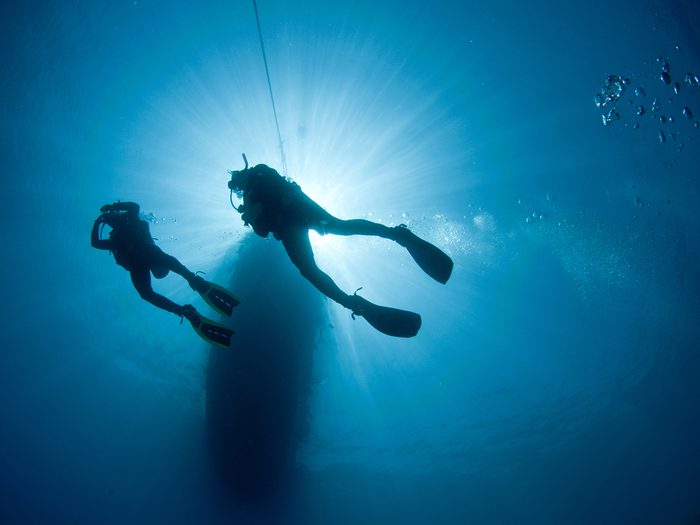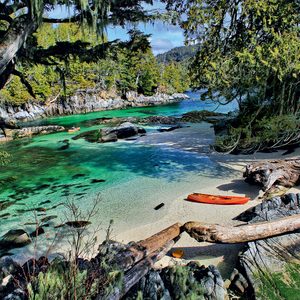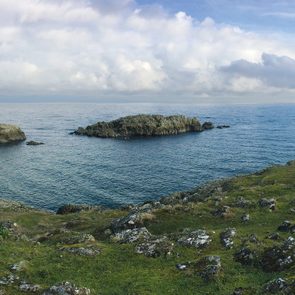A Deep Dive to Remember

A little bay near Campbell River, B.C., provided a once-in-a-lifetime experience for this lover of the sea.
One weekend in 1995 while we were practicing tai chi, my roommate asked me if I was interested in going diving with him. With my own gear and a love for the water, I was always looking for someone who wanted to head to the ocean.
Back then, not too many people had their own diving gear, so it was hard to find someone interested in diving. I never acquired a large amount of money, so my gear was a used wetsuit missing a section of material the size of a small breakfast bowl in the crotch. Wetsuits aren’t made to keep you dry, but the neoprene material wrapped tightly against your body is designed to keep you somewhat warm for the first 40 minutes of diving. Unfortunately, if you have a decent-sized hole, that will affect how warm you stay. Every time I went diving, I came back out after 30 minutes barely unable to move from the cold, but it was worth it.
My Campbell River Diving Adventure
The conditions were perfect the day we chose to go Campbell River diving. It was calm and sunny, and visibility in the water was about 40 or 50 feet—which in summer is quite good, with algae and plankton everywhere. I was feeling in great shape. We went into a little bay just off Campbell River, the local popular diving spot, as there was always an abundance of wildlife to see. We laid out our gear, checked it over and made a game plan of our dive for the next hour. We planned on checking out the wildlife within the first 50 feet for the first part of the dive, then dropping down past 150 feet. This was something I was kind of excited about trying. I had never really been past 80 feet, as there was really no need. When diving, almost everything interesting to see is within the top 30 feet.
The dive spot for the first half-hour proved its popularity: The rock reefs were covered with starfish, sea urchins and crabs working their way around the crevices, looking for food as the odd shrimp wiggled by. Every once in a while, a jellyfish bobbed up and down with little stragglers feeling its way. Close to the rocks, the anemone closed their outer soft shells when touched, covering their colourful tentacles. As we moved through the long keep, a couple of wolf eels curiously circled us before disappearing back into the darkness. As we were hoping, a Pacific octopus did let us admire him before his long arms pushed him back int a small crevice within the rock. We did not see any seals that day; however, we were able to watch hundreds of different kinds of fish.
Into the Depths
My roommate motioned to me, by thumbs up, to see if I was okay, then pointed down a rock formation with no bottom in sight. After replying back I was okay, we started down the rock wall. As I looked at my depth gauge, it slowly read 60 feet, 70 feet…then 100 feet as we continued down the rock. I was excited and nervous as I looked around, because I didn’t know what was ahead of us; this was something I had never experienced.
It was the weirdest feeling to look upward and find that the sky and ocean surface were no longer there. There was no wildlife in sight, other than barnacles glued to the rocks—and the two of us slowly descending. I started feeling as if life completely stopped and there was only the darkness all around us. You think it’s dark at night, but there is always some form of light around to give direction; at 120 feet deep with nothing but a flashlight, it was enough to make the hair on the back of my neck stand up.
We hit about 140 feet when we stopped descending. My roommate then wrote a simple addition question on a small underwater board, wanting me to answer it. He was a divemaster and was making sure that my brain was still functioning properly. With a tank, you can only dive to about 130 feet safely. After that, physiological changes brought on by pressure become greater and greater the deeper you dive, and compressed air breathing can lead to nitrogen narcosis and other problems. Being a smart ass, I decided not to do the addition problem but instead did it as a multiplication problem. He smirked at my answer and knew I was still fine, so we descended a little farther.
Terror at 160 Feet
The thing was, even though I was okay, I was very nervous about being so deep with no sight of anything. It was complete darkness—not even a shadow. I am not claustrophobic, but I was definitely feeling a bit of it. If something happened, I would be in trouble. The air in my tanks said 1,500 psi, and this is the time to ascend. The deeper you go, the greater the quantity of air is required to fill your lungs. I knew I had to try and slow down my breathing and start upwards in five minutes, which I was looking forward to.
I still don’t know why I didn’t stop and give the sign to go up, but I guess I proceeded down for the thrill of the unknown. I didn’t know till afterward how deep we went, but when we hit 160 feet, I started to lose it. I didn’t know where I was or what I was doing. I just recall looking upward, scared out of my mind. I didn’t know anything about my life, or what I did for a living. I didn’t need to communicate—I guess my eyes and facial expression said everything. My roommate was holding onto me and slowly started upward, trying to calm me down.
Once we got back up to 130 feet, I remembered what we were doing—or at least I knew who I was—but in the darkness, I still wanted to get out of the water NOW. We couldn’t just go straight up, though. Unfortunately, at that depth, we had to stop for five minutes a few times on the way up for decompression. The closer we got to the surface, the more I started to feel relaxed, especially once I saw some light above us.
We eventually did get up and out of the water, and then my buddy let me know that I had experienced nitrogen narcosis; in diving vernacular it’s called getting “narked.” Everybody varies in the depth they can reach before this occurs. Some divers have reacted by taking their air regulator out of their mouth and trying to give air to a fish, while others lose direction and try heading back by swimming deeper.
As a divemaster, my roommate’s depth was around 180 feet; he was seeing how I would cope when I got narked. It is something I never want to experience again; however, I am glad I did, for I recall clearly what I couldn’t remember—and the feeling of fear that went with it. I knew that in my future diving days, 130 feet deep would be my limit; from experience, there really is nothing more to see after 70 feet deep anyway.
Will you be adding Campbell River diving to your bucket list? Here are more hidden gems across B.C. worth exploring.






